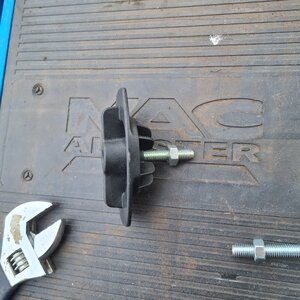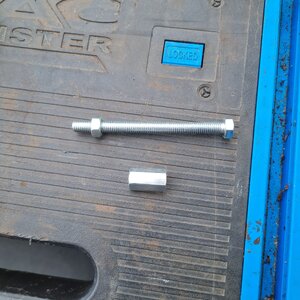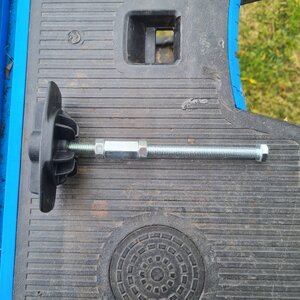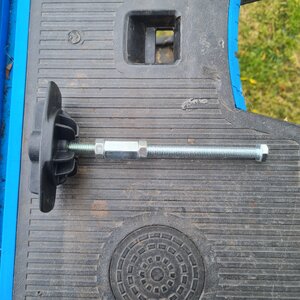Wives new car wheel size
Page 2 - Passionate about caravans & motorhome? Join our community to share that passion with a global audience!
You are using an out of date browser. It may not display this or other websites correctly.
You should upgrade or use an alternative browser.
You should upgrade or use an alternative browser.
- Nov 11, 2009
- 25,478
- 9,308
- 50,935
I don’t rotate in 2Wd cars irrespective of if the tyres are unidirectional or not. Always have best tread on the rear, again irrespective of FWD or RWD.Clive
A lot of tyres today are rotation orientated ie only in one direction. Presumably you do the rotation between front and rear same side? 😉
Now heading for bunker.
PS on AWD IE Haldex type I do same as 2WD. But in 4WD IE Subaru, Pajero, Disco I did rotate or move front to back and vice versa if unidirectional. But only on Subarau did I have unidirectional anyway.
Last edited:
- Jul 18, 2017
- 16,688
- 5,362
- 50,935
That used to be true when car were rear wheel drive, but unsure if it applies nowadays. I prefer to rotate the tyres regularly for even wear and then to replace all four at the same time.I don’t rotate in 2Wd cars irrespective of if the tyres are unidirectional or not. Always have best tread on the rear, again irrespective of FWD or RWD.
Now heading for bunker.
PS on AWD IE Haldex type I do same as 2WD. But in 4WD IE Subaru, Pajero, Disco I did rotate or move front to back and vice versa if unidirectional. But only on Subarau did I have unidirectional anyway.
- Nov 11, 2009
- 25,478
- 9,308
- 50,935
This link to Uniroyal gives a good summary. Others give similar advice and it’s independent of rwd, or fwd. Unless the driver is very skilled , few are, it’s better to reduce the risk of oversteer.That used to be true when car were rear wheel drive, but unsure if it applies nowadays. I prefer to rotate the tyres regularly for even wear and then to replace all four at the same time.

Good tyres on front or rear: Rotation and exchange according to plan
Changing and rotating tyres: Read on to find out why tyre rotation is important. And whether the good tyres should go on the front or rear.
- Jun 20, 2005
- 20,228
- 5,440
- 50,935
Sadly that’s not always possible nor necessarily desirable.That used to be true when car were rear wheel drive, but unsure if it applies nowadays. I prefer to rotate the tyres regularly for even wear and then to replace all four at the same time.
In my case two punctures meant two new rear tyres within four months. Both coincidentally are on the rear.
I now have almost brand new on the rear and 4 mm both front. They will not need changing at the same time.
That suits me. The new tyre in York in the Spring was £290. Back home 2 months later £220.
So you don’t need to be a mathematician to see how much four new tyres will cost😥.
- Nov 11, 2009
- 25,478
- 9,308
- 50,935
My generation 1 Kia Sorento allowed a mismatch between front and rear tread depth. When in 4WD having a bit more tread depth on the rears reduced unnecessary power shuffling through its transfer box. But 4WD High or Low were only recommended for lower grip surfaces. So most of the time was spent in 2WD with the rears doing the work.Sadly that’s not always possible nor necessarily desirable.
In my case two punctures meant two new rear tyres within four months. Both coincidentally are on the rear.
I now have almost brand new on the rear and 4 mm both front. They will not need changing at the same time.
That suits me. The new tyre in York in the Spring was £290. Back home 2 months later £220.
So you don’t need to be a mathematician to see how much four new tyres will cost😥.
- Jul 18, 2017
- 16,688
- 5,362
- 50,935
The last time I changed tyres on the Jeep the cost was for the four was in excess of £1200. The rear tyres which were Continental had good tread although they had seen 35k miles. They had been on the car since new. The front tyres were odd brands and one was almost new while the other showed wear. As I would needed to change the 3 tyres probably 6 months later I opted to change them at the same time as the front tyres.Sadly that’s not always possible nor necessarily desirable.
In my case two punctures meant two new rear tyres within four months. Both coincidentally are on the rear.
I now have almost brand new on the rear and 4 mm both front. They will not need changing at the same time.
That suits me. The new tyre in York in the Spring was £290. Back home 2 months later £220.
So you don’t need to be a mathematician to see how much four new tyres will cost😥.
I like the same amount of tread all round on a car to prevent any reaction between the two axles on an AWD or 4x4 vehicle!
- Nov 11, 2009
- 25,478
- 9,308
- 50,935
Some AWD, as opposed to 4WD, such as the widely used Haldex are relatively insensitive to tread depth as far as interaction between the fronts and rears are concerned. My Volvo XC70 and Skoda Superb were both AWD Haldex systems as was my sons Freelander 2. This type of system does most of its driving through the front tyres until slippage is sensed on the rear, when some power shift then takes place front to back. Early generation Haldex were 90/10% front to rear then up to 50/50% when required. They were primarily mechanical operating on wheel slip. Generation 5 is still primarily front biased but takes inputs from wheel sensors, yaw sensors, ECU etc and can anticipate the need for power transfer more quickly than earlier generations. So this basically means that tyre wear in many AWD cars is very much like that in a 2WD car.The last time I changed tyres on the Jeep the cost was for the four was in excess of £1200. The rear tyres which were Continental had good tread although they had seen 35k miles. They had been on the car since new. The front tyres were odd brands and one was almost new while the other showed wear. As I would needed to change the 3 tyres probably 6 months later I opted to change them at the same time as the front tyres.
I like the same amount of tread all round on a car to prevent any reaction between the two axles on an AWD or 4x4 vehicle!
I'm sure you're right about your own Forester but Subaru use 3 different types of 4WD systems, depending on the power output and transmission - my 2006 Outback (non-turbo automatic) used a multi-plate clutch to transfer drive to the rear axle, technically full-time as the clutch pressure was modulated between 10-100% but allowing some degree of slip so front:rear tread depth wasn't that critical.Yes Subaru are sensitive as it’s full time four wheel drive with center differential. From memory the recommendation was less than 1mm variation all around. So tyre rotation was a must around every 5000 miles.
The RAV is 2WD so tyre rotation not as important as on the Forester. So I tend to run fronts down to 3mm, remove, bring rears to the front and then put new tyres on the rear. All helps to keep the back end where you want it.
I know what you mean about Kwik Fiit but in Wales on a Sunday it was a case of needs must. But it got me out of a hole as you might say. 😂
From an engineering point of view, a true centre differential allows different rotation speeds front:rear so tyre diameter is less crucial.
- Nov 11, 2009
- 25,478
- 9,308
- 50,935
Mine was the last model Forester XT turbo, before they were discontinued.I'm sure you're right about your own Forester but Subaru use 3 different types of 4WD systems, depending on the power output and transmission - my 2006 Outback (non-turbo automatic) used a multi-plate clutch to transfer drive to the rear axle, technically full-time as the clutch pressure was modulated between 10-100% but allowing some degree of slip so front:rear tread depth wasn't that critical.
From an engineering point of view, a true centre differential allows different rotation speeds front:rear so tyre diameter is less crucial.
- Feb 13, 2024
- 1,414
- 894
- 1,435
Just to confirm , the wheel in question is a suzuki, not kia, subaru etc. If you want to know about different wheel rotation start your own thread and stop hijacking mine. Thanks to the ops, for genuine replies.
- Jul 18, 2017
- 16,688
- 5,362
- 50,935
You had the answered way back in earlier posts so surely no harm with the thread is now being hijacked?Just to confirm , the wheel in question is a suzuki, not kia, subaru etc. If you want to know about different wheel rotation start your own thread and stop hijacking mine. Thanks to the ops, for genuine replies.
- Feb 13, 2024
- 1,414
- 894
- 1,435
- Nov 11, 2009
- 25,478
- 9,308
- 50,935
So where are you on your quest for the Suzuki Ignis?Just to confirm , the wheel in question is a suzuki, not kia, subaru etc. If you want to know about different wheel rotation start your own thread and stop hijacking mine. Thanks to the ops, for genuine replies.
- Feb 13, 2024
- 1,414
- 894
- 1,435
Have a few Spare wheel lined up, took rear wheel of and it fits perfectly in wheel well. On rear of wheel was size 16x5j.So where are you on your quest for the Suzuki Ignis?
- Feb 13, 2024
- 1,414
- 894
- 1,435
- Feb 13, 2024
- 1,414
- 894
- 1,435

Practical Caravan is part of Future plc, an international media group and leading digital publisher. Visit our corporate site.
© Future Publishing Limited Quay House, The Ambury, Bath BA1 1UA. All rights reserved. England and Wales company registration number 2008885.




